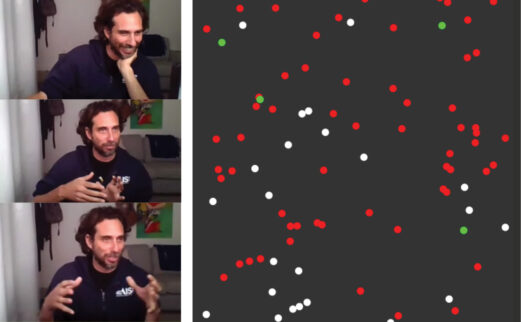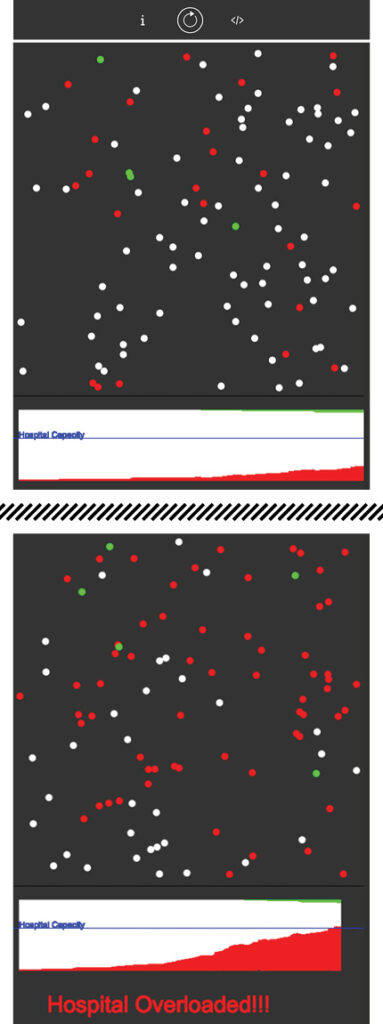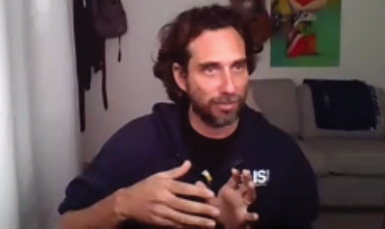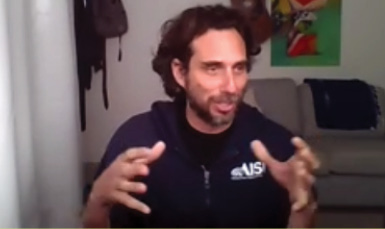
The first virtual Big Orange STEM Saturday (BOSS) for high school students, held November 21, 2020, focused on the most urgent issue of our time: stemming the spread of the COVID-19 novel coronavirus.
The featured presenter, however, was not an epidemiologist but a computer scientist. Amir Sadovnik is an assistant professor in UT’s Department of Electrical Engineering and Computer Science. His research interests include computer models, artificial intelligence, and machine learning.
He demonstrated how computer models help us devise plans to combat COVID-19.
Sadovnik created a simplified computer model that simulates transmission of the virus over time (see Virus Spread by Amir Sadovnik). Dots representing persons move randomly within their environment (a square boundary). As uninfected individuals (represented by white dots) encounter infected individuals (red dots), they too become infected. Over time, infected individuals recover and become green dots. A continuously updated graph records changes in the numbers of uninfected, infected, and recovered individuals in real time. A static line across the graph indicates local Hospital Capacity.
Just as the National Weather Service uses computer modeling to predict the weather, we can enter varying data and encode different assumptions into the Virus Spread model to explain, predict, and test various scenarios for transmission of the coronavirus.
Sadovnik used Processing, a simple but flexible coding language, to create his model.

Play with the Virus Spread model – it’s easy and intriguing! Click on “</>” at the top center of the webpage to see the underlying code and change some of the variables (in purple). The triangle at top center will relaunch the model.
For instance, increasing the value associated with “int num” (number of people in the square) lets the investigator test what will happen if we fail to observe social distancing measures. Setting a lower value for “int infect_distance” (distance at which people infect each other) reflects outcomes should the virus mutate to become more highly contagious. Keep an eye on the graph at the bottom to see whether the total of active infections (red area) exceeds the local Hospital Capacity. This is a clear illustration of why we want to “flatten the curve” — i.e., slow the rate of COVID-19 spread so that it does not overwhelm hospital capacity.
At Big Orange STEM Saturday (BOSS), students were given a tough assignment: Use the computer model to inform decisions on school policy during the coronavirus pandemic. Students were divided into teams, assigned to breakout rooms, and asked to imagine that “Your team has been hired to be consultants for a school district providing the option to return to face-to-face teaching in schools after winter break.”
The teams used the computer model to test how their policy decisions would affect whether students could safely enter and exit the school building, walk the hallways, and participate in classrooms with peers.
Approximately 100 students from Knoxville and East Tennessee high schools attended the virtual event.
Students from the University of Tennessee and Maryville College acted as facilitators to the breakout rooms. Facilitators included both undergraduate and graduate students who are studying math, computer science, or the sciences. Most of the facilitators plan to eventually teach high school math or science and are current participants in UT’s VolsTeach program. The VolsTeach students and Graduate Library Assistants provided technical assistance and other behind-the-scenes support for BOSS.
Big Orange STEM Saturday is presented annually by the University of Tennessee Libraries and UT’s Center for Enhanced Education in Mathematics and Sciences. Other supporters of this year’s event were the East Tennessee STEM Hub, the VolsTeach Program, the College Access and Persistence Services (CAPS) Outreach Center, and the VolShop.
BOSS conference producers were Lynn Hodge, Nick Kim, Rebecca Layton, and Thura Mack. Lynn Hodge is director of the East Tennessee STEM Hub and at UT she is director of the Center for Enhancing Education in Mathematics and Sciences (CEEMS), co-director of VolsTeach, and a professor in the Department of Theory and Practice in Teacher Education (TPTE). Nick Kim is project coordinator at CEEMS and a doctoral student in mathematics education. Rebecca Layton is clinical assistant professor in TPTE and a media specialist for the East Tennessee STEM Hub. Thura Mack is coordinator of community learning services and diversity programs at the UT Libraries.


